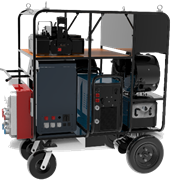Take you through the industry advantages of pipeline welding robots
Date:2021-12-08 Views:810
Welding, as an industrial "tailor", is a very important processing method in industrial production. Meanwhile, due to the presence of welding dust, arc light, and metal spatter, the working environment for welding is very harsh, and welding quality plays a decisive role in product quality. Unfortunately, although China already has a series of welding robot products with independent intellectual property rights, they cannot be mass-produced or scaled up.

In ordinary low alloy steel, in addition to carbon, there are also small amounts of other elements, such as manganese, silicon, vanadium, molybdenum, titanium, aluminum, niobium, copper, boron, phosphorus, rare earth, etc., which undergo changes in properties, resulting in better performance than ordinary carbon steel, such as high-strength steel, corrosion-resistant steel, low-temperature steel, heat-resistant steel, etc.
At present, most of the pipeline automatic welding equipment put into use in China are welding robots or fixed pipeline prefabrication systems. Welding workpieces can only be prefabricated in the factory workshop and then transported to the construction site for welding by welders. Manual arc welding is still mainly used for on-site pipeline construction, and is currently a common production method in pipeline welding construction sites, which has many inconveniences. Therefore, there is a great potential for the application and development of on-site construction pipeline welding robots in China.
Most of China's oil and gas resources are distributed in the northeast and northwest regions, while the vast majority of consumer markets are located in densely populated areas, such as large and medium-sized cities along the southeast coast and central and southern regions. The severe separation of production and sales markets has made the transportation of oil and gas products the biggest obstacle to the development and utilization of oil and gas resources. Pipeline transportation is the best way to overcome this obstacle.
Welding, as an industrial "tailor", is a very important processing method in industrial production. Meanwhile, due to the presence of welding dust, arc light, and metal spatter, the working environment for welding is very harsh, and welding quality plays a decisive role in product quality. Unfortunately, although China already has a series of welding robot products with independent intellectual property rights, they cannot be mass-produced or scaled up.

In ordinary low alloy steel, in addition to carbon, there are also small amounts of other elements, such as manganese, silicon, vanadium, molybdenum, titanium, aluminum, niobium, copper, boron, phosphorus, rare earth, etc., which undergo changes in properties, resulting in better performance than ordinary carbon steel, such as high-strength steel, corrosion-resistant steel, low-temperature steel, heat-resistant steel, etc.
At present, most of the pipeline automatic welding equipment put into use in China are welding robots or fixed pipeline prefabrication systems. Welding workpieces can only be prefabricated in the factory workshop and then transported to the construction site for welding by welders. Manual arc welding is still mainly used for on-site pipeline construction, and is currently a common production method in pipeline welding construction sites, which has many inconveniences. Therefore, there is a great potential for the application and development of on-site construction pipeline welding robots in China.
Most of China's oil and gas resources are distributed in the northeast and northwest regions, while the vast majority of consumer markets are located in densely populated areas, such as large and medium-sized cities along the southeast coast and central and southern regions. The severe separation of production and sales markets has made the transportation of oil and gas products the biggest obstacle to the development and utilization of oil and gas resources. Pipeline transportation is the best way to overcome this obstacle.











